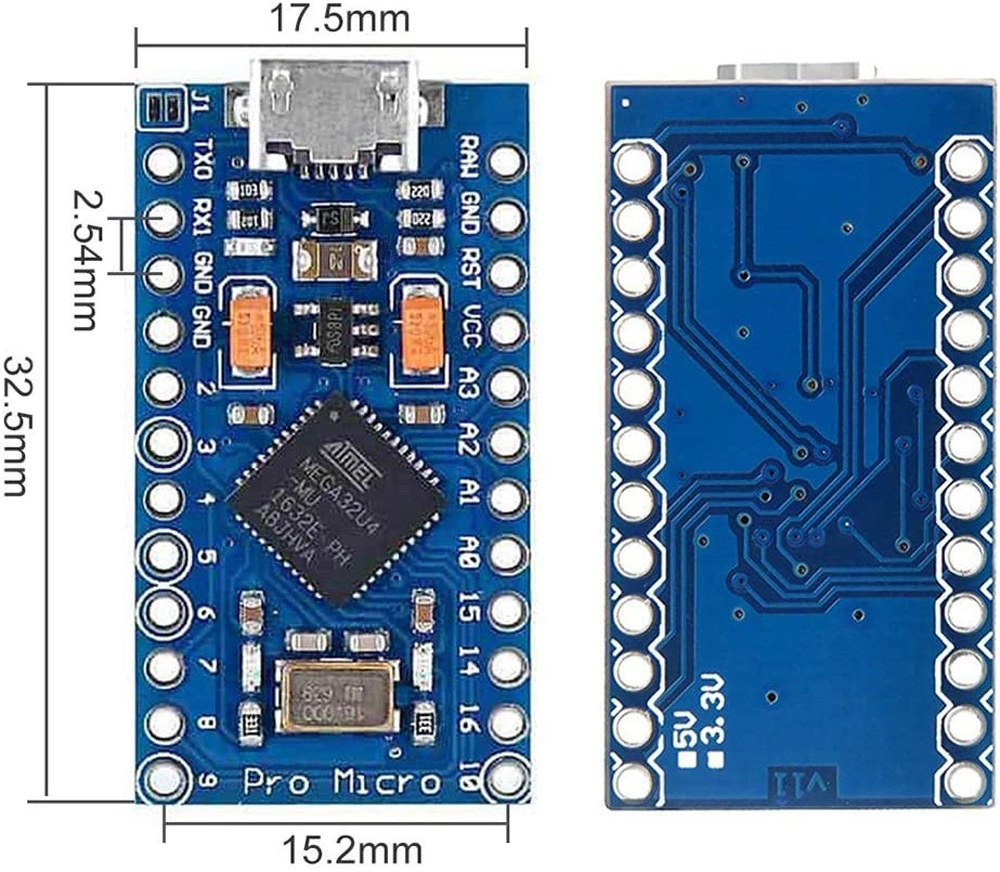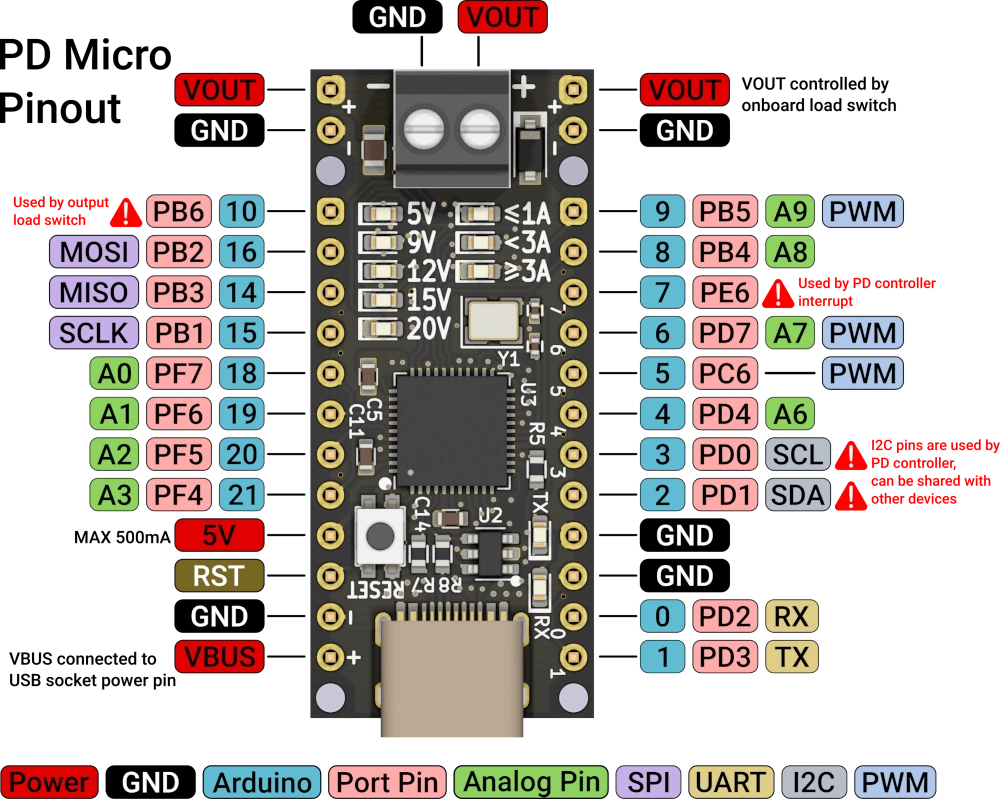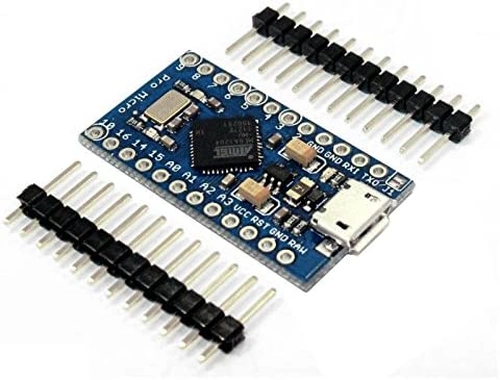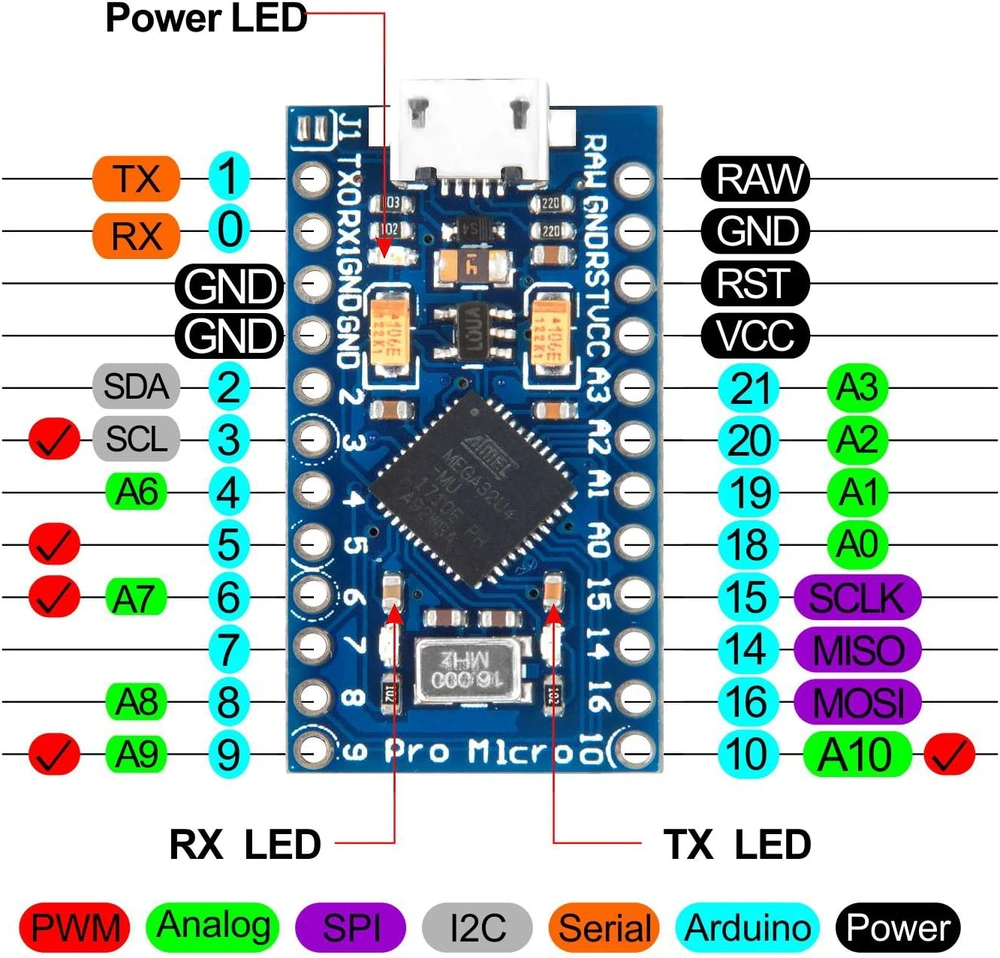
Table of Contents
Introduction
The Arduino Pro Micro is a small microcontroller board that is designed to be used for projects where space is at a premium. It is based on the ATmega32U4 microcontroller, the same chip as the Arduino Leonardo.
Despite the name and the fact that the Pro Micro adheres to the exact same specification as the Arduino Leonardo this board is not in fact an Arduino product. The Pro Micro is an Arduino-compatible microcontroller board developed under an open hardware license by SparkFun Electronics. SparkFun makes a wide arrangement of modules, accessories and more types of products which work in conjunction with the Arduino ecosystem, as well as the Raspberry Pi ecosystem, with support for many other microcontroller boards produced by a wide range of different manufacturers.

This is a high-performance 8-bit AVR microcontroller with 32 KB of flash memory, 2.5 KB of SRAM, and 1 KB of EEPROM. With 18 digital input/output pins, 5 analog inputs, and a range of other features, the Arduino Pro Micro is a versatile board that can be used for a wide range of small projects.
The Pro Micro along with the Leonardo are the only two Arduino boards to date that come out of the box ready to act an HID — Human Interface Device — which means to a pc they both can appear as any common peripheral.
This is another in our series comparing different microcontrollers available to the hobbyist. For a table laying out all of the specs for the Pro Micro as well as every other microcontroller we’ve covered to far see here.
Specifications
The Arduino Pro Micro has a range of specifications that make it a useful microcontroller board for small projects. Here are some of the key specifications:
- – Microcontroller: ATmega32U4
- – Operating Voltage: 5V
- – Input Voltage: 5V
- – Digital I/O Pins: 18
- – PWM Channels: 7
- – Analog Input Pins: 5
- – DC Current per I/O Pin: 40 mA
- – Flash Memory: 32 KB (4 KB used by bootloader)
- – SRAM: 2.5 KB
- – EEPROM: 1 KB
- – Clock Speed: 16 MHz
Pinout

Digital I/O Pins
The Arduino Pro Micro has 18 digital input/output pins that can be used for a range of applications, such as controlling LEDs, reading sensors, and communicating with other devices. Of the 18 pins, 7 provide PWM output, which is useful for controlling the brightness of LEDs or the speed of motors.
Analog Input Pins
The Arduino Pro Micro has 5 analog input pins, which can be used to read analog sensors such as temperature sensors, light sensors, and potentiometers. These analog input pins have a resolution of 10 bits, which means they can detect 1024 different levels of analog input.
Communication Interfaces
The Arduino Pro Micro has a range of communication interfaces, including one UART (hardware serial port), SPI (Serial Peripheral Interface), and I2C (Inter-Integrated Circuit). These communication interfaces allow the Arduino Pro Micro to communicate with other devices, such as sensors, displays, and other microcontrollers. The Pro Micro along with the Arduino Leonardo are the two boards that support native USB communication right out of the box. This allows you to configure via software whether the board is recognized as either a standard Arduino, a mouse, keyboard, or both. With the Joystick Library the Pro Micro can appear as a game controller, steering wheel, flight stick, or most any other HID — Human Interface Device — as well.

Memory
The Arduino Pro Micro has 32 KB of flash memory, which is used to store the program code. It also has 2.5 KB of SRAM, which is used for variables and other data that the program needs to store. In addition, it has 1 KB of EEPROM, which can be used to store data that needs to be retained even when the power is turned off.
Power
The Arduino Pro Micro is designed to be powered with 5V DC power. It can be powered via the USB connection, or via the RAW pin, which can accept input voltages up to 12V.
Compatibility
The Arduino Pro Micro is compatible with libraries designed for the Arduino Leonardo, which makes it a useful choice for small projects. There are Pro Micro specific shields out there, a shield for the Leonardo can be made to work with a carrier board, or by running leads from the shield to the corresponding pins on the Pro Micro. This is due to the two boards being of drastically different sizes. Shields are add-on boards that can be used to add additional functionality to the Arduino, such as Ethernet connectivity, motor control, or GPS.

Programming
The Arduino Pro Micro can be programmed using the Arduino Integrated Development Environment (IDE), which is a free software development environment that is available for Windows, Mac, and Linux. The IDE provides a simple interface for writing and uploading code to the Arduino Pro Micro, as well as a range of libraries and examples to help get started with programming. For additional information see the official documentation here.
Conclusion
The Arduino Pro Micro is a useful microcontroller board that is suitable for small projects that require a compact and low-power microcontroller. With its 18 digital input/output pins, 5 analog inputs, and communication interfaces such as UART, SPI, and I2C, the Arduino Pro Micro offers a range of features that make it versatile and flexible for small projects. Its compact size and low power requirements also make it suitable for projects that need to be portable or run on battery power. Additionally, the ability to be programmed using the Arduino IDE and compatibility with shields designed for the Arduino Leonardo or Micro makes it easy to get started with creating projects.
Overall, the Arduino Pro Micro is a useful microcontroller board for small projects that require a compact and low-power microcontroller. With its range of features and compatibility with shields, it is a versatile and flexible choice for those looking to create small electronic projects.
Related
See a detailed rundown of the Pro Micro’s big brother the Arduino Leonardo here.
Need to compare microcontrollers to decide which one goes in your next project? Our microcontroller comparison table is what you need to help you decide. Or you can see all of our coverage of Arduino boards here, and our coverage of all microcontrollers is here.
[…] different microcontroller boards to find the one that is just right for your project here, our rundown of the Arduino Pro Micro can be found here, and you can see all of the microcontroller boards we have covered so far […]